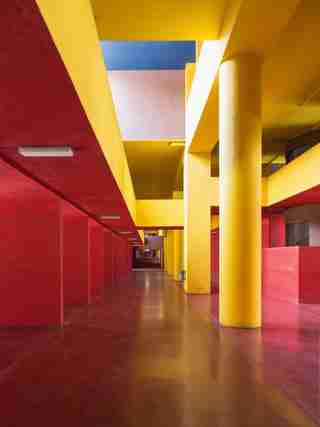Many terms have been used to describe the city of Milan : fashion capital, art and design center, financial hub, and, perhaps most commonly, Italy’s Ugly City. Milan’s crumbling historic buildings, dirty streets, and many industrial complexes have supported the notion that—save for a few iconic structures—the city has little to offer in the way of classically beautiful architecture. A new Taschen publication aims to prove that Milan is actually a city of great beauty—on the inside. Titled Entryways of Milan (May 2017), this forthcoming volume invites readers on a pictorial tour of the city’s grand modernist entryways from Italy’s most influential designers and architects, including Giovanni Muzio, Luigi Caccia Dominioni, Gio Ponti, and Piero Portaluppi.
Here’s a peek into 13 august and opulent Milanese entryways, ranging from ornate and colorful creations to minimalist architectural masterworks.

Designed by Giuseppe Roberto Martinenghi, this entryway, constructed in 1937, features Arabescato Carrara marble floors and walls of limestone and marble.

Upon entering Palazzo Sola-Busca by Aldo Andreani, visitors encounter an imposing staircase of Botticino limestone.

This light-filled space on via Francesco Cilea features a surprising color palette.
The pastel-filled interior of viale Severino Boezio 2 features a chandelier and sconces by Aureliano Toso and granite walls.
From floor to ceiling, geometric patterns abound in this interior view of viale Giustiniano 5.
Pier Giulio Magistretti designed this space from 1934 to 1936 and employed both classical elements, like pillars, and modernist motifs, like the geometric ceiling.
The tranquil tone of this space at Gabriele Rossetti 19 was created through the use of natural shapes and elements, such as wood panels and the spiraling floor pattern.
View from Mario Giuriati 5, where muted tones and exciting patterns meld to form an unexpected entryway.
Symmetry is a key design element of this sleek and modern interior at via Marcona 49.
Inside via Paravia 37, visitors encounter an intriguing mix of color, texture, and material.
This monochromatic modern entryway features a door sculpture by Gio Pomodoro and pendant lamps by Venin. The space was designed by Giandomenico Belotti, Sergio Invernizzi, and Achille Boraschi, 1958–60.
The interior of via Giuseppe Dezza 49 can be recognized by its charming pops of color on both the walls and in the limestone and marble floors. The space was designed by Gio Ponti, Antonio Fornaroli, and Alberto Rosselli, 1952–56.
Designed by Vincenzo d’Alo in 1935, this marble-filled entryway is accented by a pendant lamp by Luigi Caccia Dominioni.

Leave a Reply